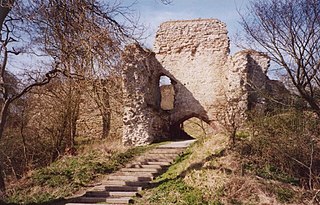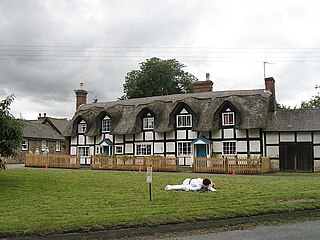
Sir Robert Harley was an English statesman who served as Master of the Mint for Charles I. A devout Puritan, he supported Parliament in the Wars of the Three Kingdoms.

New Radnor is a village in Powys, Wales, to the south of Radnor Forest, and was the county town of Radnorshire.

Beeston Castle is a former Royal castle in Beeston, Cheshire, England, perched on a rocky sandstone crag 350 feet (107 m) above the Cheshire Plain. It was built in the 1220s by Ranulf de Blondeville, 6th Earl of Chester (1170–1232), on his return from the Crusades. In 1237, Henry III took over the ownership of Beeston, and it was kept in good repair until the 16th century, when it was considered to be of no further military use, although it was pressed into service again in 1643, during the English Civil War. The castle was slighted in 1646, in accordance with Cromwell's destruction order, to prevent its further use as a bastion. During the 18th century, parts of the site were used as a quarry.

Donnington Castle is a ruined medieval castle, situated in the small village of Donnington, just north of the town of Newbury in the English county of Berkshire. It was founded by Sir Richard Abberbury the Elder in 1386 and was bought by Thomas Chaucer before the castle was taken under royal control during the Tudor period. During the First English Civil War the castle was held by the royalist Sir John Boys and withstood an 18-month siege; after the garrison eventually surrendered, Parliament voted to demolish Donnington Castle in 1646. Only the gatehouse survives. The site is a scheduled monument under the care of English Heritage.
Sir Henry Lingen, Lord of Sutton, Lingen and Stoke Edith, was a Royalist military commander in Herefordshire during the English Civil War, and later a member of parliament. He was the son of Edward Lingen and Blanche Bodenham. He fathered 2 sons, Henry and William and 7 daughters, Elizabeth, Joan, Blanch, Mary (Dobbyns), Cecilia, Frances (Unett), and Alice (Herring). Both sons died without issue but the daughters left considerable posterity.
Brilliana, Lady Harley, néeBrilliana Conway, was an English letter writer.

Wigmore Castle is a ruined castle about 1 km (0.62 mi) from the village of Wigmore in the northwest region of Herefordshire, England.

Skipton Castle is a Grade I Listed medieval castle in Skipton, North Yorkshire, England. It was built in 1090 by Robert de Romille, a Norman baron, and has been preserved for over 931 years.

Brampton Bryan is a small village and civil parish situated in north Herefordshire, England close to the Shropshire and Welsh borders.

Sir Edward Harley, 21 October 1624 to 8 December 1700, was an English politician from Herefordshire. A devout Puritan who fought for Parliament in the First English Civil War, Harley belonged to the moderate Presbyterian faction, which opposed the involvement of the New Model Army in the peace negotiations that followed victory in 1646. Elected MP for Herefordshire in 1646, he was one of the Eleven Members forced into temporary exile by the army in 1647.
The siege of Gloucester took place between 10 August and 5 September 1643 during the First English Civil War. It was part of a Royalist campaign led by King Charles I to take control of the Severn Valley from the Parliamentarians. Following the costly storming of Bristol on 26 July, Charles invested Gloucester in the hope that a show of force would prompt it to surrender quickly and without bloodshed. When the city, under the governorship of Lieutenant-Colonel Edward Massey, refused, the Royalists attempted to bombard it into submission. Massey adopted an aggressive defence, and the Royalist positions outside the city were regularly disrupted by Parliamentarian raids. The Royalist artillery proved inadequate for the task of siege work and, faced with a shortage of ammunition, the besiegers attempted to breach the city walls by mining. With Royalist miners about to reach the city's east gate and the defenders critically low on gunpowder, a Parliamentarian army led by the Earl of Essex arrived and forced Charles to lift the siege.

Earl of Oxford and Earl Mortimer was a title in the Peerage of Great Britain. It was created in 1711 for the statesman Robert Harley, with remainder, failing heirs male of his body, to those of his grandfather, Sir Robert Harley. He was made Baron Harley, of Wigmore in the County of Hereford, at the same time, also in the Peerage of Great Britain and with similar remainder as for the earldom. Harley was the eldest son of Sir Edward Harley and the grandson of the aforementioned Sir Robert Harley.

Farleigh Hungerford Castle, sometimes called Farleigh Castle or Farley Castle, is a medieval castle in Farleigh Hungerford, Somerset, England. The castle was built in two phases: the inner court was constructed between 1377 and 1383 by Sir Thomas Hungerford, who made his fortune as steward to John of Gaunt. The castle was built to a quadrangular design, already slightly old-fashioned, on the site of an existing manor house overlooking the River Frome. A deer park was attached to the castle, requiring the destruction of the nearby village. Sir Thomas's son, Sir Walter Hungerford, a knight and leading courtier to Henry V, became rich during the Hundred Years War with France and extended the castle with an additional, outer court, enclosing the parish church in the process. By Walter's death in 1449, the substantial castle was richly appointed, and its chapel decorated with murals.

Sir William Savile, 3rd Baronet of Thornhill was an English politician who sat in the House of Commons between 1640 and 1642. He fought on the Royalist side in the English Civil War and was killed in action.
Fitzwilliam Coningsby was an English politician who sat in the House of Commons in 1621 and in 1640. He supported the Royalist cause in the English Civil War.
Sir Robert Harley FRS was an English politician who sat in the House of Commons from 1647 to 1648 and in 1660.

Hemyock Castle is a ruined 14th-century castle in the village of Hemyock, Devon, England. It was built by Sir William Asthorpe after 1380 to a quadrangular design. It would have been visually impressive, but not particularly functional, with various intrinsic flaws. By the 16th century it had fallen into ruin and, following its use during the English Civil War in the mid-17th century, it was pulled down (slighted). In the 21st century the site is occupied by the fragments of the original castle; and Castle House, an 18th-century house built within the site, and restored as private home at the end of the 20th century.

Brampton Bryan Hall is a 17th-century English country house in the village of Brampton Bryan, Herefordshire. It is still owned by the descendants of Robert Harley, Earl of Oxford, chief minister under Queen Anne and is a Grade II* listed building.

Wardour Castle in Wiltshire was besieged twice during the First English Civil War; once in May 1643, and then again between November 1643 and March 1644. During the first siege, a Parliamentarian force of around 1,300 men led by Sir Edward Hungerford attacked the castle, which was the home of Thomas Arundell, 2nd Baron Arundell of Wardour, a prominent Catholic and Royalist. Arundell was absent, fighting for King Charles at the time of the attack, and the defence was led by his wife, Lady Blanche Arundell, in command of 25 soldiers. The siege was started on 2 May, and lasted for a week before the Parliamentarians forced Lady Arundell to surrender on 8 May. The Parliamentarians garrisoned the castle with 75 men, led by Colonel Edmund Ludlow.
Sir Charles Vavasour, 1st Baronet, of Killingthorpe was an English soldier who fought the insurgents in the Irish Rebellion of 1641 where he excelled at the Battle of Liscarroll in 1642 but was defeated in the Battle of Cloughleagh of the ensuing Irish Confederate Wars. After the cease-fire of September 1643 he was sent to England to fight the Parliamentarians in the First English Civil War, but his regiment mutinied and he resigned his commission, dying soon after in Oxford.
















